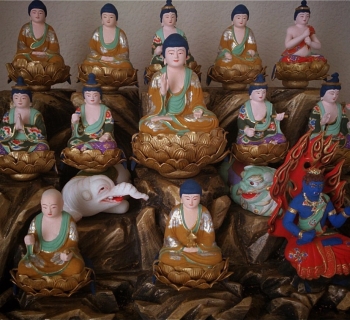13 Buddhas | Jūsan Butsu | Shingon
The Thirteen Buddhas (Jūsan Butsu) is a Japanese grouping of Buddha aspects, characteristic to the Shingon tradition of Buddhism.
The Buddha-aspects are, in fact, not only Buddhas, but include Bodhisattvas and Wisdom Kings.
In Shingon services, lay followers recite a devotional mantra to each Buddha-aspect, though in Shingon practice, disciples will typically devote themselves to only one, depending on what the teacher assigns.
In Shingon Buddhism there are many Buddhas in whom followers have a special sacred connection. Each has special characteristics for which they are believed in. These many Buddhas have their own special vows and powers of salvation.
This is just as it is with people in society, all of whom serve in the world with their own specialties in various spheres.
For example, the Bodhisattva Avalokiteśvara, the Bodhisattva Kṣitigarbha (Jizō), Acala Vidyārāja (Fudō Myōō), Vaiśravaṇa (Bishamonten), Benten (Benzaiten), and Kōbō Daishi (Kūkai, 774-835 ), who became a Buddha, can all be the main deity around which people focus their belief in different temples.
Jūsan Butsu, the 13 Buddhas of the Shingon School, are often found represented together in painted images consisting of 5 Buddhas, 7 Bodhisattvas and Fudō Myōō. All together they represent the chief deities of the Taizōkai (Womb Realm, garbha-kośa-dhātu) and Kongōkai (Diamond Realm, vajra-dhātu) mandalas.
In Shingon these 13 Buddhas assist people during their life and continue to assist them after death to guide them into the realm of enlightenment.
The 13 Buddha-aspects according to Shingon tradition and often venerated also in Tendai Buddhism are:
- Fudō-Myōō (Acala)
- Shaka Nyorai (Śākyamuni)
- Monju Bosatsu (Mañjuśrī)
- Fugen Bosatsu (Samantabhadra)
- Jizō Bosatsu (Kṣitigarbha)
- Miroku Bosatsu (Maitreya)
- Yakushi Nyorai (Bhaiṣajyaguru)
- Kannon Bosatsu (Avalokiteśvara)
- Seishi Bosatsu (Mahāsthāmaprāpta)
- Amida Nyorai (Amitābha)
- Ashuku Nyorai (Akṣobhya)
- Dainichi Nyorai (Vairocana)
- Kokūzō Bosatsu (Ākāśagarbha)
While the 13 Buddha-aspects have several mantras associated to each respectively, the following mantras pertain to the standard formula used in Japanese ritual.
The Shingon and Tendai schools each use a different method of transliteration of the original Sanskrit. Bhaiṣajyaguru is the only figure whose mantra fundamentally differs between traditions.
(Sanskrit) namaḥ samanta vajrāṇāṁ caṇḍa mahāroṣaṇa sphoṭaya hūṁ traṭ hāṁ māṁ
(Shingon) nōmaku sanmanda bazara dan senda makaroshada sowataya untarata kanman
(Tendai) namaku samanda bazaranan senda makaroshana sowataya untarata kanman
2. Shaka Nyorai (Śākyamuni):
(Sanskrit) namaḥ samanta buddhānāṁ bhaḥ
(Shingon) nōmaku sanmanda bodanan baku
(Tendai) namaku samanda bodanan ba
3. Monju bosatsu (Mañjuśrī):
(Sanskrit) oṁ a ra pa ca na
(Shingon) on arahashanō
(Tendai) on a ra ha sha na
4. Fugen bosatsu (Samantabhadra):
(Sanskrit) oṁ samayas tvaṁ
(Shingon) on sanmaya satoban
(Tendai) on samaya sataban
5. Jizō bosatsu (Kṣitigarbha):
(Sanskrit) oṁ ha ha ha vismaye svāhā
(Shingon) on kakaka bisanmaei sowaka
(Tendai) on kakakabi samaei sowaka
6. Miroku bosatsu (Maitreya):
(Sanskrit) oṁ maitreya svāhā
(Shingon) on maitareiya sowaka
(Tendai) on maitariya sowaka
7. Yakushi Nyorai (Bhaiṣajyaguru):
(Sanskrit) oṁ huru huru caṇḍāli mātangi svāhā
(Shingon) on korokoro sendari matōgi sowaka
(Sanskrit) oṁ bhaiṣajye bhaiṣajye bhaiṣajya samudgate svāhā
(Tendai) on baiseizeibaiseizei baiseijasanborgyatei sowaka
8. Kannon Bosatsu (Avalokiteśvara):
(Sanskrit) oṁ ārolik svāhā
(Shingon) on arorikya sowaka
(Tendai) on arorikya sowaka
9. Seishi bosatsu (Mahāsthāmaprāpta):
(Sanskrit) oṁ saṁ jaṁ jaṁ saḥ svāhā
(Shingon) on san zan saku sowaka
(Tendai) on sanzen zensaku sowaka
10. Amida Nyorai (Amitābha):
(Sanskrit) oṁ amṛta teje hara hūṁ
(Shingon) on amirita teisei kara un
(Tendai) on amirita teisei kara un
11. Ashuku Nyorai (Akshobhya):
(Sanskrit) oṁ Akṣobhya hūṁ
(Shingon) on akishubiya un
(Tendai) on akishubiya un
12. Dainichi Nyorai (Vairocana):
(Sanskrit) oṁ a vi ra hūṁ khaṁ vajradhātu vaṁ
(Shingon) on abiraunken basara datoban
(Tendai) on abiraunken basara datoban
13. Kokūzō bosatsu (Ākāśagarbha):
(Sanskrit) namo ākāśagarbhaya oṁ ārya kamari mauli svāhā
(Shingon) nōbō akyashakyarabaya on arikya mari bori sowaka
(Tendai) namo akyashagerubaya onarikya maribori sowaka
The 13 Buddhas are also an important part of a traditional Japanese Buddhist funeral service, with each deity having a corresponding memorial service for the deceased.
The 13 dates of memorial service by living Shingon followers for the deceased believer is as follows:
- Fudō (Acala), 7th day
- Shaka (Śākyamuni), 14th day
- Monju (Mañjuśrī), 21st day
- Fugen (Samantabhadra), 28th day
- Jizō (Kṣitigarbha), 35th day
- Miroku (Maitreya), 42nd day
- Yakushi (Bhaiṣajyaguru), 49th day
- Kannon (Avalokiteśvara), 100th day
- Seishi (Mahāsthāmaprāpta), 1st anniversary
- Amida (Amitābha), 2nd anniversary
- Ashuku (Akṣobhya), 6th anniversary
- Dainichi (Vairocana), 12th anniversary
- Kokūzō (Ākāśagarbha), 32nd anniversary

